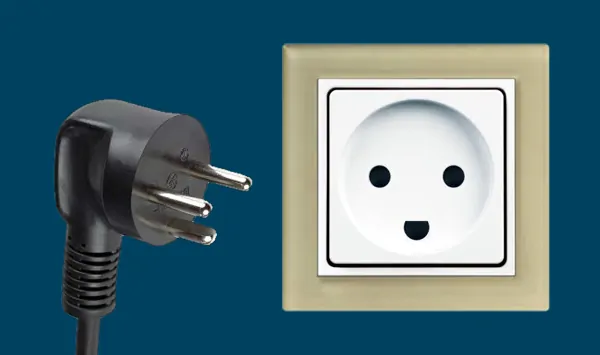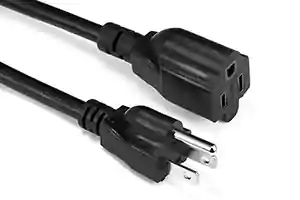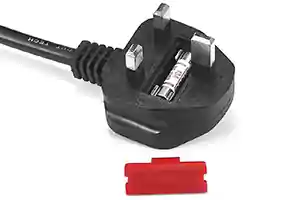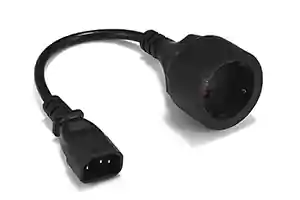The Danish standard type K plug is unique to Denmark. Unlike the similar type E plug, the grounding pin is not mounted in the receptacle but is on the plug itself. to the Type C “Euro plug,” except it has an earth pin off to one side.

Table of Contents
What is a Type K plug?
The electrical Type K plug has two round pins and a spade grounding pin. It is similar to the Type E electrical plug but has an earth pin rather than an earth hole on the pin and an earth hole rather than an earth pin on the socket.
Type K plug features
The Danish standard is described in DS 60884-2-D1. Unlike the similar type E plug, the grounding pin is not mounted in the receptacle but is on the plug itself.
The U-shaped earthing pin is 14 mm long, 4 mm thick, and 6.5 mm in diameter. The line and the neutral pins of type K are round and have a 4.8 mm diameter. They are 19 mm in length, and their centers are spaced 19 mm apart. The center-to-center distance between the earth pin and the middle of the imaginary line connecting the two power pins is 13 mm. The plug is rated at 16 A, and a type C plug fits perfectly into a type K socket.

The Danish socket will also accept plug types E and F: however, there is no grounding connection with these plugs because a male ground pin is required on the plug. Because of the huge amount of imported European appliances fitted with E/F plugs, the Danish government decided to make it legal to install type E or F sockets too.
So, the expectation is that, in the long term, the standard European type F socket (or – but this is less likely – the less frequently used type E) will eventually replace the Danish type K socket.ected to the mains with an appropriate high power industrial connector.
What countries use type K plug?
Type K is used almost exclusively in Denmark and Greenland.
Used in countries:
| Denmark | 230V 50Hz | Power socket: Type C, Type E, Type F, Type K |
| Bangladesh | 220V 50Hz | Power socket: Type C, Type D, Type G, Type K |
| Faroe Islands | 230V 50Hz | Power socket: Type C, Type E, Type F, Type K |
| Greenland | 230V 50Hz | Power socket: Type C, Type E, Type F, Type K |
| Guinea | 220V 50Hz | Power socket: Type C, Type F, Type K |
| Madagascar | 127V / 220V 50Hz | Power socket: Type C, Type D, Type E, Type J, Type K |
| Saint Vincent and the Grenadines | 230V 50Hz | Power socket: Type A, Type C, Type E, Type G, Type I, Type K |
| Senegal | 230V 50Hz | Power socket: Type C, Type D, Type E, Type K |
Information on The Type K Electrical Outlet
Technically known as the Danish 10 A/250 V, this plug is the Danish standard plug. The Danish Type K socket will also accept Type C and Type F. Though Type E plugs will also fit into the socket, it should not be used for appliances that need to be earthed.
A variation of the Danish plug, the standard DK 2-5a, also exists for surge-protected computer circuits. It fits into the corresponding socket and the standard Type K, but the standard Type K plugs do not fit into the special Type K computer socket by design.
In the past, Danish sockets were equipped with a switch to prevent the live pins from touching when connecting or disconnecting the plug. Today, sockets without switches are allowed, but they are required to have a cavity that prevents the pins from touching.
However, the shape of the plugs makes it rare that the live pins will touch. New electronic installations in Denmark are required to have grounded outlets, and older installations don’t have this requirement, but they must be protected by RCD/GFCI (HFI in Danish). Since 2008, wall outlets for Type E French plugs have been permitted in Denmark, but sockets for Type F will not.
Type K electrical plug certificate
Organization: DEMKO
The Denmark AFSNIT 107-2-D1 standard 3 prong 13 amp is also referred to as SRAF 1962/DB 16/87. Power cords manufactured in compliance with Denmark AFSNIT 107-2-D1 standards. DEMKO agency approvals and certifications are available on the product specification page.
We have made a very detailed graphic introduction in the article safety marks for more information about the safety certification of power cord plugs.
Now It’s Your Turn
So that’s how I understand the type K plug and socket.
Now I want to turn it over to you: Through my article, do you understand Type K electrical plugs and Sockets (Outlets)?
Do you have a different point of view with the Type K power plug? Or any other questions?
Let me know by leaving a quick comment below right now.




